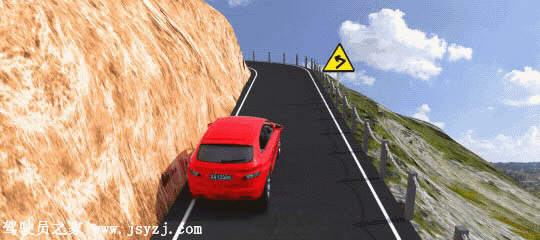1、When making a turn on a mountainous road, drivers should cut speed, sound the horn and drive along the right side.

A、Right
B、Wrong
Answer:A
2、What should the driver pay attention to in this situation?

A、Pedestrians passing behind the vehicle
B、Pedestrians passing in front of the vehicle
C、Public buses suddenly reversing
D、Public buses suddenly setting off
Answer:B
3、The sign on the right warns of a danger from rockfall on the left side.

A、Right
B、Wrong
Answer:A
4、When a motor vehicle equipped with ABS makes an emergency brake, the driver can tread the brake pedal heavily.
A、Right
B、Wrong
Answer:A
5、How will the adhesive force of road change when speed increases on a damp and slippery road?
A、Increase sharply
B、increase gradually
C、decrease sharply
D、No change
Answer:C
6、What should be checked before driving?
A、No parts need to be checked
B、Whether the tires have been cleaned
C、Where the spare tire is placed
D、The fastening and air pressure of tires
Answer:D
7、When a wounded person is unable to get off the vehicle by himself/herself, he/she should be removed from the vehicle so as to avoid a secondary injury.
A、Right
B、Wrong
Answer:A
8、The sign on the right indicates that the speed limit of 40km/hour is lifted on the road ahead.

A、Right
B、Wrong
Answer:B
9、What should the driver do on this kind of curving mountain road?

A、Borrow the opposite lane
B、Slow down and drive on the right
C、Stick to the central line of the road
D、Drive close to the right side
Answer:B
10、Under such circumstances, what should the motor venicle driver do?

A、Reduce speed and yield by the left side
B、Reduce speed and yield by the right side
C、Speed up and yield by the left side
D、Go ahead along the original route
Answer:A
11、When the rear wheels of a motor vehicle skid sideways on a muddy road, the driver should turn the steering wheel in the opposite direction of the side skid.
A、Right
B、Wrong
Answer:B
12、The sign in front indicates a temporary parking lot on the right side of the highway.

A、Right
B、Wrong
Answer:B
13、When approaching another vehicle at night, why should the driver alternate between high-and-low-beam at a distance more than 150 meters?
A、Warn each other before passing
B、Driving habit
C、Easy to observe the situation ahead from either side
D、Courtesy
Answer:C
14、When a motor vehicle has deviated from the straight moving direction and an accident is unavoidable, the driver should decisively and continuously depress the brake pedal so as to shorten the stopping distance and reduce the impact of vehicle collision.
A、Right
B、Wrong
Answer:A
15、What should be done by the driver who intends to overtake but the motor vehicle in front neither reduces its speed nor allows the right of way?
A、Continuously sounding the horn and accelerating to overtake
B、Accelerating and continuing to overtake
C、Refraining from overtaking
D、Following the vehicle in front closely and finding a chance to overtake
Answer:C
16、The sign on the right indicates to stop and yield at the intersection ahead.

A、Right
B、Wrong
Answer:A
17、The sign on the right indicates that driving along left side only.

A、Right
B、Wrong
Answer:A
18、As shown in the flash, the driver's act is correct.

A、Right
B、Wrong
Answer:B
19、The sign on the right warns of a guarded railway intersection ahead.

A、Right
B、Wrong
Answer:B
20、The broken and solid white line on the road indicates that crossing is allowed on the solid line side.

A、Right
B、Wrong
Answer:B